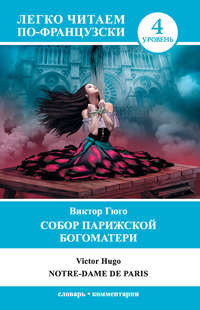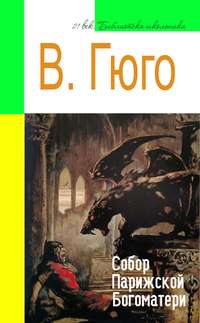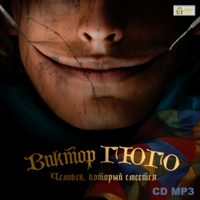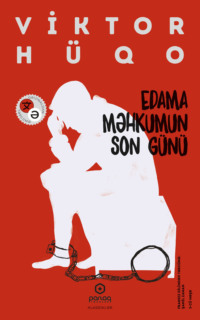 полная версия
полная версияThe Man Who Laughs
It is very fortunate that kings cannot err. Hence their contradictions never perplex us. In approving always, one is sure to be always right – which is pleasant. Louis XIV. would not have liked to see at Versailles either an officer acting the cock, or a prince acting the turkey. That which raised the royal and imperial dignity in England and Russia would have seemed to Louis the Great incompatible with the crown of St. Louis. We know what his displeasure was when Madame Henriette forgot herself so far as to see a hen in a dream – which was, indeed, a grave breach of good manners in a lady of the court. When one is of the court, one should not dream of the courtyard. Bossuet, it may be remembered, was nearly as scandalized as Louis XIV.
IV
The commerce in children in the 17th century, as we have explained, was connected with a trade. The Comprachicos engaged in the commerce, and carried on the trade. They bought children, worked a little on the raw material, and resold them afterwards.
The venders were of all kinds: from the wretched father, getting rid of his family, to the master, utilizing his stud of slaves. The sale of men was a simple matter. In our own time we have had fighting to maintain this right. Remember that it is less than a century ago since the Elector of Hesse sold his subjects to the King of England, who required men to be killed in America. Kings went to the Elector of Hesse as we go to the butcher to buy meat. The Elector had food for powder in stock, and hung up his subjects in his shop. Come buy; it is for sale. In England, under Jeffreys, after the tragical episode of Monmouth, there were many lords and gentlemen beheaded and quartered. Those who were executed left wives and daughters, widows and orphans, whom James II. gave to the queen, his wife. The queen sold these ladies to William Penn. Very likely the king had so much per cent. on the transaction. The extraordinary thing is, not that James II. should have sold the women, but that William Penn should have bought them. Penn's purchase is excused, or explained, by the fact that having a desert to sow with men, he needed women as farming implements.
Her Gracious Majesty made a good business out of these ladies. The young sold dear. We may imagine, with the uneasy feeling which a complicated scandal arouses, that probably some old duchesses were thrown in cheap.
The Comprachicos were also called the Cheylas, a Hindu word, which conveys the image of harrying a nest.
For a long time the Comprachicos only partially concealed themselves. There is sometimes in the social order a favouring shadow thrown over iniquitous trades, in which they thrive. In our own day we have seen an association of the kind in Spain, under the direction of the ruffian Ramon Selles, last from 1834 to 1866, and hold three provinces under terror for thirty years – Valencia, Alicante, and Murcia.
Under the Stuarts, the Comprachicos were by no means in bad odour at court. On occasions they were used for reasons of state. For James II. they were almost an instrumentum regni. It was a time when families, which were refractory or in the way, were dismembered; when a descent was cut short; when heirs were suddenly suppressed. At times one branch was defrauded to the profit of another. The Comprachicos had a genius for disfiguration which recommended them to state policy. To disfigure is better than to kill. There was, indeed, the Iron Mask, but that was a mighty measure. Europe could not be peopled with iron masks, while deformed tumblers ran about the streets without creating any surprise. Besides, the iron mask is removable; not so the mask of flesh. You are masked for ever by your own flesh – what can be more ingenious? The Comprachicos worked on man as the Chinese work on trees. They had their secrets, as we have said; they had tricks which are now lost arts. A sort of fantastic stunted thing left their hands; it was ridiculous and wonderful. They would touch up a little being with such skill that its father could not have known it. Et que méconnaîtrait l'oeil même de son père, as Racine says in bad French. Sometimes they left the spine straight and remade the face. They unmarked a child as one might unmark a pocket-handkerchief. Products, destined for tumblers, had their joints dislocated in a masterly manner – you would have said they had been boned. Thus gymnasts were made.
Not only did the Comprachicos take away his face from the child, they also took away his memory. At least they took away all they could of it; the child had no consciousness of the mutilation to which he had been subjected. This frightful surgery left its traces on his countenance, but not on his mind. The most he could recall was that one day he had been seized by men, that next he had fallen asleep, and then that he had been cured. Cured of what? He did not know. Of burnings by sulphur and incisions by the iron he remembered nothing. The Comprachicos deadened the little patient by means of a stupefying powder which was thought to be magical, and suppressed all pain. This powder has been known from time immemorial in China, and is still employed there in the present day. The Chinese have been beforehand with us in all our inventions – printing, artillery, aerostation, chloroform. Only the discovery which in Europe at once takes life and birth, and becomes a prodigy and a wonder, remains a chrysalis in China, and is preserved in a deathlike state. China is a museum of embryos.
Since we are in China, let us remain there a moment to note a peculiarity. In China, from time immemorial, they have possessed a certain refinement of industry and art. It is the art of moulding a living man. They take a child, two or three years old, put him in a porcelain vase, more or less grotesque, which is made without top or bottom, to allow egress for the head and feet. During the day the vase is set upright, and at night is laid down to allow the child to sleep. Thus the child thickens without growing taller, filling up with his compressed flesh and distorted bones the reliefs in the vase. This development in a bottle continues many years. After a certain time it becomes irreparable. When they consider that this is accomplished, and the monster made, they break the vase. The child comes out – and, behold, there is a man in the shape of a mug!
This is convenient: by ordering your dwarf betimes you are able to have it of any shape you wish.
V
James II. tolerated the Comprachicos for the good reason that he made use of them; at least it happened that he did so more than once. We do not always disdain to use what we despise. This low trade, an excellent expedient sometimes for the higher one which is called state policy, was willingly left in a miserable state, but was not persecuted. There was no surveillance, but a certain amount of attention. Thus much might be useful – the law closed one eye, the king opened the other.
Sometimes the king went so far as to avow his complicity. These are audacities of monarchical terrorism. The disfigured one was marked with the fleur-de-lis; they took from him the mark of God; they put on him the mark of the king. Jacob Astley, knight and baronet, lord of Melton Constable, in the county of Norfolk, had in his family a child who had been sold, and upon whose forehead the dealer had imprinted a fleur-de-lis with a hot iron. In certain cases in which it was held desirable to register for some reason the royal origin of the new position made for the child, they used such means. England has always done us the honour to utilize, for her personal service, the fleur-de-lis.
The Comprachicos, allowing for the shade which divides a trade from a fanaticism, were analogous to the Stranglers of India. They lived among themselves in gangs, and to facilitate their progress, affected somewhat of the merry-andrew. They encamped here and there, but they were grave and religious, bearing no affinity to other nomads, and incapable of theft. The people for a long time wrongly confounded them with the Moors of Spain and the Moors of China. The Moors of Spain were coiners, the Moors of China were thieves. There was nothing of the sort about the Comprachicos; they were honest folk. Whatever you may think of them, they were sometimes sincerely scrupulous. They pushed open a door, entered, bargained for a child, paid, and departed. All was done with propriety.
They were of all countries. Under the name of Comprachicos fraternized English, French, Castilians, Germans, Italians. A unity of idea, a unity of superstition, the pursuit of the same calling, make such fusions. In this fraternity of vagabonds, those of the Mediterranean seaboard represented the East, those of the Atlantic seaboard the West. Many Basques conversed with many Irishmen. The Basque and the Irishman understand each other – they speak the old Punic jargon; add to this the intimate relations of Catholic Ireland with Catholic Spain – relations such that they terminated by bringing to the gallows in London one almost King of Ireland, the Celtic Lord de Brany; from which resulted the conquest of the county of Leitrim.
The Comprachicos were rather a fellowship than a tribe; rather a residuum than a fellowship. It was all the riffraff of the universe, having for their trade a crime. It was a sort of harlequin people, all composed of rags. To recruit a man was to sew on a tatter.
To wander was the Comprachicos' law of existence – to appear and disappear. What is barely tolerated cannot take root. Even in the kingdoms where their business supplied the courts, and, on occasions, served as an auxiliary to the royal power, they were now and then suddenly ill-treated. Kings made use of their art, and sent the artists to the galleys. These inconsistencies belong to the ebb and flow of royal caprice. "For such is our pleasure."
A rolling stone and a roving trade gather no moss. The Comprachicos were poor. They might have said what the lean and ragged witch observed, when she saw them setting fire to the stake, "Le jeu n'en vaut pas la chandelle." It is possible, nay probable (their chiefs remaining unknown), that the wholesale contractors in the trade were rich. After the lapse of two centuries, it would be difficult to throw any light on this point.
It was, as we have said, a fellowship. It had its laws, its oaths, its formulæ – it had almost its cabala. Any one nowadays wishing to know all about the Comprachicos need only go into Biscaya or Galicia; there were many Basques among them, and it is in those mountains that one hears their history. To this day the Comprachicos are spoken of at Oyarzun, at Urbistondo, at Leso, at Astigarraga. Aguardate niño, que voy a llamar al Comprachicos– Take care, child, or I'll call the Comprachicos – is the cry with which mothers frighten their children in that country.
The Comprachicos, like the Zigeuner and the Gipsies, had appointed places for periodical meetings. From time to time their leaders conferred together. In the seventeenth century they had four principal points of rendezvous: one in Spain – the pass of Pancorbo; one in Germany – the glade called the Wicked Woman, near Diekirsch, where there are two enigmatic bas-reliefs, representing a woman with a head and a man without one; one in France – the hill where was the colossal statue of Massue-la-Promesse in the old sacred wood of Borvo Tomona, near Bourbonne les Bains; one in England – behind the garden wall of William Challoner, Squire of Gisborough in Cleveland, Yorkshire, behind the square tower and the great wing which is entered by an arched door.
VI
The laws against vagabonds have always been very rigorous in England. England, in her Gothic legislation, seemed to be inspired with this principle, Homo errans fera errante pejor. One of the special statutes classifies the man without a home as "more dangerous than the asp, dragon, lynx, or basilisk" (atrocior aspide, dracone, lynce, et basilico). For a long time England troubled herself as much concerning the gipsies, of whom she wished to be rid as about the wolves of which she had been cleared. In that the Englishman differed from the Irishman, who prayed to the saints for the health of the wolf, and called him "my godfather."
English law, nevertheless, in the same way as (we have just seen) it tolerated the wolf, tamed, domesticated, and become in some sort a dog, tolerated the regular vagabond, become in some sort a subject. It did not trouble itself about either the mountebank or the travelling barber, or the quack doctor, or the peddler, or the open-air scholar, as long as they had a trade to live by. Further than this, and with these exceptions, the description of freedom which exists in the wanderer terrified the law. A tramp was a possible public enemy. That modern thing, the lounger, was then unknown; that ancient thing, the vagrant, was alone understood. A suspicious appearance, that indescribable something which all understand and none can define, was sufficient reason that society should take a man by the collar. "Where do you live? How do you get your living?" And if he could not answer, harsh penalties awaited him. Iron and fire were in the code: the law practised the cauterization of vagrancy.
Hence, throughout English territory, a veritable "loi des suspects" was applicable to vagrants (who, it must be owned, readily became malefactors), and particularly to gipsies, whose expulsion has erroneously been compared to the expulsion of the Jews and the Moors from Spain, and the Protestants from France. As for us, we do not confound a battue with a persecution.
The Comprachicos, we insist, had nothing in common with the gipsies. The gipsies were a nation; the Comprachicos were a compound of all nations – the lees of a horrible vessel full of filthy waters. The Comprachicos had not, like the gipsies, an idiom of their own; their jargon was a promiscuous collection of idioms: all languages were mixed together in their language; they spoke a medley. Like the gipsies, they had come to be a people winding through the peoples; but their common tie was association, not race. At all epochs in history one finds in the vast liquid mass which constitutes humanity some of these streams of venomous men exuding poison around them. The gipsies were a tribe; the Comprachicos a freemasonry – a masonry having not a noble aim, but a hideous handicraft. Finally, their religions differ – the gipsies were Pagans, the Comprachicos were Christians, and more than that, good Christians, as became an association which, although a mixture of all nations, owed its birth to Spain, a devout land.
They were more than Christians, they were Catholics; they were more than Catholics, they were Romans, and so touchy in their faith, and so pure, that they refused to associate with the Hungarian nomads of the comitate of Pesth, commanded and led by an old man, having for sceptre a wand with a silver ball, surmounted by the double-headed Austrian eagle. It is true that these Hungarians were schismatics, to the extent of celebrating the Assumption on the 29th August, which is an abomination.
In England, so long as the Stuarts reigned, the confederation of the Comprachicos was (for motives of which we have already given you a glimpse) to a certain extent protected. James II., a devout man, who persecuted the Jews and trampled out the gipsies, was a good prince to the Comprachicos. We have seen why. The Comprachicos were buyers of the human wares in which he was dealer. They excelled in disappearances. Disappearances are occasionally necessary for the good of the state. An inconvenient heir of tender age whom they took and handled lost his shape. This facilitated confiscation; the tranfer of titles to favourites was simplified. The Comprachicos were, moreover, very discreet and very taciturn. They bound themselves to silence, and kept their word, which is necessary in affairs of state. There was scarcely an example of their having betrayed the secrets of the king. This was, it is true, for their interest; and if the king had lost confidence in them, they would have been in great danger. They were thus of use in a political point of view. Moreover these artists furnished singers for the Holy Father. The Comprachicos were useful for the Miserere of Allegri. They were particularly devoted to Mary. All this pleased the papistry of the Stuarts. James II. could not be hostile to holy men who pushed their devotion to the Virgin to the extent of manufacturing eunuchs. In 1688 there was a change of dynasty in England: Orange supplanted Stuart. William III. replaced James II.
James II. went away to die in exile, miracles were performed on his tomb, and his relics cured the Bishop of Autun of fistula – a worthy recompense of the Christian virtues of the prince.
William, having neither the same ideas nor the same practices as James, was severe to the Comprachicos. He did his best to crush out the vermin.
A statute of the early part of William and Mary's reign hit the association of child-buyers hard. It was as the blow of a club to the Comprachicos, who were from that time pulverized. By the terms of this statute those of the fellowship taken and duly convicted were to be branded with a red-hot iron, imprinting R. on the shoulder, signifying rogue; on the left hand T, signifying thief; and on the right hand M, signifying man-slayer. The chiefs, "supposed to be rich, although beggars in appearance," were to be punished in the collistrigium– that is, the pillory – and branded on the forehead with a P, besides having their goods confiscated, and the trees in their woods rooted up. Those who did not inform against the Comprachicos were to be punished by confiscation and imprisonment for life, as for the crime of misprision. As for the women found among these men, they were to suffer the cucking-stool – this is a tumbrel, the name of which is composed of the French word coquine, and the German stuhl. English law being endowed with a strange longevity, this punishment still exists in English legislation for quarrelsome women. The cucking-stool is suspended over a river or a pond, the woman seated on it. The chair is allowed to drop into the water, and then pulled out. This dipping of the woman is repeated three times, "to cool her anger," says the commentator, Chamberlayne.
PART I
BOOK THE FIRST.
NIGHT NOT SO BLACK AS MAN
CHAPTER I.
PORTLAND BILL
An obstinate north wind blew without ceasing over the mainland of Europe, and yet more roughly over England, during all the month of December, 1689, and all the month of January, 1690. Hence the disastrous cold weather, which caused that winter to be noted as "memorable to the poor," on the margin of the old Bible in the Presbyterian chapel of the Nonjurors in London. Thanks to the lasting qualities of the old monarchical parchment employed in official registers, long lists of poor persons, found dead of famine and cold, are still legible in many local repositories, particularly in the archives of the Liberty of the Clink, in the borough of Southwark, of Pie Powder Court (which signifies Dusty Feet Court), and in those of Whitechapel Court, held in the village of Stepney by the bailiff of the Lord of the Manor. The Thames was frozen over – a thing which does not happen once in a century, as the ice forms on it with difficulty owing to the action of the sea. Coaches rolled over the frozen river, and a fair was held with booths, bear-baiting, and bull-baiting. An ox was roasted whole on the ice. This thick ice lasted two months. The hard year 1690 surpassed in severity even the famous winters at the beginning of the seventeenth century, so minutely observed by Dr. Gideon Delane – the same who was, in his quality of apothecary to King James, honoured by the city of London with a bust and a pedestal.
One evening, towards the close of one of the most bitter days of the month of January, 1690, something unusual was going on in one of the numerous inhospitable bights of the bay of Portland, which caused the sea-gulls and wild geese to scream and circle round its mouth, not daring to re-enter.
In this creek, the most dangerous of all which line the bay during the continuance of certain winds, and consequently the most lonely – convenient, by reason of its very danger, for ships in hiding – a little vessel, almost touching the cliff, so deep was the water, was moored to a point of rock. We are wrong in saying, The night falls; we should say the night rises, for it is from the earth that obscurity comes. It was already night at the bottom of the cliff; it was still day at top. Any one approaching the vessel's moorings would have recognized a Biscayan hooker.
The sun, concealed all day by the mist, had just set. There was beginning to be felt that deep and sombrous melancholy which might be called anxiety for the absent sun. With no wind from the sea, the water of the creek was calm.
This was, especially in winter, a lucky exception. Almost all the Portland creeks have sand-bars; and in heavy weather the sea becomes very rough, and, to pass in safety, much skill and practice are necessary. These little ports (ports more in appearance than fact) are of small advantage. They are hazardous to enter, fearful to leave. On this evening, for a wonder, there was no danger.
The Biscay hooker is of an ancient model, now fallen into disuse. This kind of hooker, which has done service even in the navy, was stoutly built in its hull – a boat in size, a ship in strength. It figured in the Armada. Sometimes the war-hooker attained to a high tonnage; thus the Great Griffin, bearing a captain's flag, and commanded by Lopez de Medina, measured six hundred and fifty good tons, and carried forty guns. But the merchant and contraband hookers were very feeble specimens. Sea-folk held them at their true value, and esteemed the model a very sorry one, The rigging of the hooker was made of hemp, sometimes with wire inside, which was probably intended as a means, however unscientific, of obtaining indications, in the case of magnetic tension. The lightness of this rigging did not exclude the use of heavy tackle, the cabrias of the Spanish galleon, and the cameli of the Roman triremes. The helm was very long, which gives the advantage of a long arm of leverage, but the disadvantage of a small arc of effort. Two wheels in two pulleys at the end of the rudder corrected this defect, and compensated, to some extent, for the loss of strength. The compass was well housed in a case perfectly square, and well balanced by its two copper frames placed horizontally, one in the other, on little bolts, as in Cardan's lamps. There was science and cunning in the construction of the hooker, but it was ignorant science and barbarous cunning. The hooker was primitive, just like the praam and the canoe; was kindred to the praam in stability, and to the canoe in swiftness; and, like all vessels born of the instinct of the pirate and fisherman, it had remarkable sea qualities: it was equally well suited to landlocked and to open waters. Its system of sails, complicated in stays, and very peculiar, allowed of its navigating trimly in the close bays of Asturias (which are little more than enclosed basins, as Pasages, for instance), and also freely out at sea. It could sail round a lake, and sail round the world – a strange craft with two objects, good for a pond and good for a storm. The hooker is among vessels what the wagtail is among birds – one of the smallest and one of the boldest. The wagtail perching on a reed scarcely bends it, and, flying away, crosses the ocean.
These Biscay hookers, even to the poorest, were gilt and painted. Tattooing is part of the genius of those charming people, savages to some degree. The sublime colouring of their mountains, variegated by snows and meadows, reveals to them the rugged spell which ornament possesses in itself. They are poverty-stricken and magnificent; they put coats-of-arms on their cottages; they have huge asses, which they bedizen with bells, and huge oxen, on which they put head-dresses of feathers. Their coaches, which you can hear grinding the wheels two leagues off, are illuminated, carved, and hung with ribbons. A cobbler has a bas-relief on his door: it is only St. Crispin and an old shoe, but it is in stone. They trim their leathern jackets with lace. They do not mend their rags, but they embroider them. Vivacity profound and superb! The Basques are, like the Greeks, children of the sun; while the Valencian drapes himself, bare and sad, in his russet woollen rug, with a hole to pass his head through, the natives of Galicia and Biscay have the delight of fine linen shirts, bleached in the dew. Their thresholds and their windows teem with faces fair and fresh, laughing under garlands of maize; a joyous and proud serenity shines out in their ingenious arts, in their trades, in their customs, in the dress of their maidens, in their songs. The mountain, that colossal ruin, is all aglow in Biscay: the sun's rays go in and out of every break. The wild Jaïzquivel is full of idylls. Biscay is Pyrenean grace as Savoy is Alpine grace. The dangerous bays – the neighbours of St. Sebastian, Leso, and Fontarabia – with storms, with clouds, with spray flying over the capes, with the rages of the waves and the winds, with terror, with uproar, mingle boat-women crowned with roses. He who has seen the Basque country wishes to see it again. It is the blessed land. Two harvests a year; villages resonant and gay; a stately poverty; all Sunday the sound of guitars, dancing, castanets, love-making; houses clean and bright; storks in the belfries.











